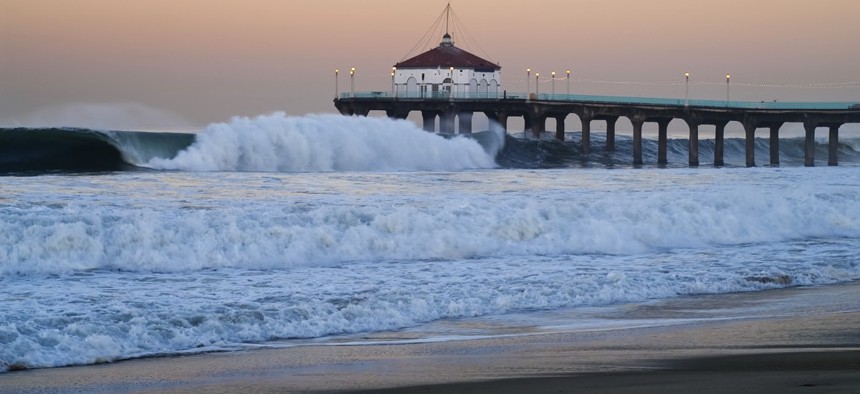Municipal Websites Prep Residents for El Niño Impacts

Rough waters hit Manhattan Beach Pier Thomas J. Sebourn / Shutterstock.com
Coastal California communities have prepared for the worst. And they’ve been preparing their digital portals, too.
The possibility of above-average rainfall and flooding caused by El Niño has coastal California cities making their websites central pillars of their emergency preparedness strategies while also reassuring residents.
San Luis Obispo—about halfway between Los Angeles and San Francisco—boosted its Web presence almost two years ago switching to Vision Internet’s content management system, great for addressing changing community conditions during droughts and wildfires.
So shifting focus to an often unpredictable seasonal weather phenomenon like El Niño in the winter isn’t a stretch.
“While we certainly want people to be prepared, we also want them to know we haven’t simply been waiting for clouds to form on the horizon,” Fire Chief Garret Olson told Route Fifty in an interview. “We’ll be creating special pages for storms but realize people don’t have time to go through all that, so we’ve done our due diligence to ensure they can type in the word ‘storm’ on our homepage and pull up a lot of information.”
A few months ago, information on the defensible space around homes during wildfires was featured, and static pages on flood preparedness from cleaning gutters in advance to getting insured and even 72-hour self-sustainability are already available on the site.
City officials anticipate more rainfall than usual this winter, but they’re seasoned veterans of flooding during the times of heavier precipitation in the 1960s, ’80s and ’90s.
In fact, the city government is using its website to tell residents just how many years of planning they’ve put into preparing for this winter: increasing the capacity of San Luis Obispo’s storm drain system, providing swift-water training to flood responders, waterproofing maps, and developing geographic information system (GIS) maps for flood inundation zones.
On Monday, all municipal departments will gather for a gap analysis meeting, where they’ll pour over a master spreadsheet with a tab for each agency and develop a communications plan for El Niño-spawned storms.
Previously, searching for storm information on the city’s website would have forced citizens to wade through pages of city council reports, but this winter San Luis Obispo will use its website to disseminate multimedia, press releases, emails and official memos on preparedness.
Just under 200 miles south along the coast near Los Angeles, Manhattan Beach is making its own El Niño preparations.
The city selected Vision Internet as its CMS provider in 2007 and used its website to invite residents to a special El Niño storm preparedness meeting in October.
Video of the meeting will be made publicly available online, just like information on harvesting stormwater for landscaping irrigation.
“We need to get ahead of the storms with information and be proactive—this is what is happening, and this is why it happens,” Leilani Emnace, a Manhattan Beach information systems manager, said in an interview.
Every city department is represented on an El Niño task force headed by the local fire department.
City Hall flooded during the last major rainstorm, Emnace said, and having a task force ensures decisions can be made outside the building.
Sandbag pickup locations will be shared on Manhattan Beach’s website, as well as barrel pickup for stormwater harvesting.
The city’s Open City Hall page will be used to solicit resident feedback on flood preparedness topics—the last one, on the location of a new skatepark, seeing 349 visits and 84 responses equalling 6.1 hours of public comment.
A notification service for local governments and agencies, Nixle’s street closure posts appear on Manhattan Beach’s website, Facebook and Twitter, and the site also has a never-been-used newsflash feature.
“We haven’t had to use it yet,” Emnace said. “El Niño may be the first time we have to use it to tell people where they need to go and where to get the supplies they need, so if things get really bad we can proactively notify residents.”
Dave Nyczepir is a News Editor at Government Executive’s Route Fifty.
NEXT STORY: Finances for Kansas City, St. Louis Could Be Hobbled by Legislation in Missouri






